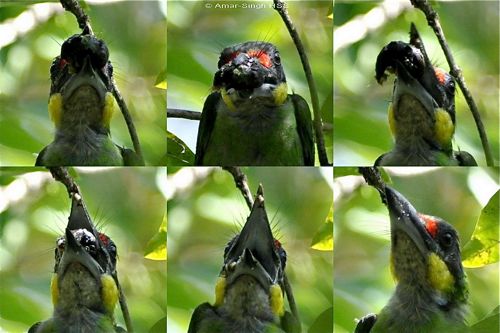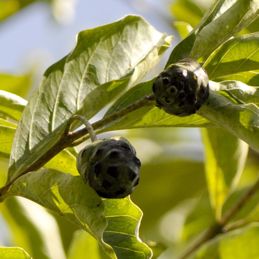This is another feeding observation by Dato’ Dr Amar-Singh HSS but this time by the Gold-whiskered Barbet (Megalaima chrysopogon) feeding on black morinda, also known as mengkudu daun kecil (Morinda elliptica) fruits. The location was the Kledang-Sayong Forest Reserve in Perak, Malaysia. It was on 12th September 2009.
“In my experience this is the friendliest of the barbets. Both the Coppersmith Barbet (Megalaima haemacephala) and Lineated Barbet (Megalaima lineata hodgsoni) visit our garden daily but are relatively shy, the Lineated more than the Coppersmith.
“But the Gold-whiskered Barbet has allowed me many watching opportunities to observe its feeding habits, usually from 3-4 m distance, sometimes closer. It does not seem very disturbed by the camera as well.
“Generally I have seen the Gold-whiskered Barbet feed on figs but it was interesting to watch a group of four feeding on the morinda. And as far as I could make out, all four birds were adults. They meticulously searched the tree and devoured all the available ‘ripe’ ones. The fruit looks hard but watching them eat, it is obviously soft within.
“Once a fruit was selected, it was first crushed between the mandibles (above). The head of the bird swung side to side to enhance this activity. Once the fruit was sufficiently squashed, it was swallowed.”
This black morinda is named as such because the fruit, actually a compound fruiting head developing from many flowers, ripens black and lumpy (left). It is closely related to great morinda or mengkudu besar (M. citrifolia), the fruits of which gives you the health drink, noni. To make your own noni, you collect the ripe fruits, pack them inside a bottle and leave it out in the sun. The clear liquid that collects at the bottom of the bottle can be taken, a spoonful a day, if you believe in its curative properties. And if you can tolerate the putrid odour.
All images by Amar-Singh HSS (Dato, Dr)










